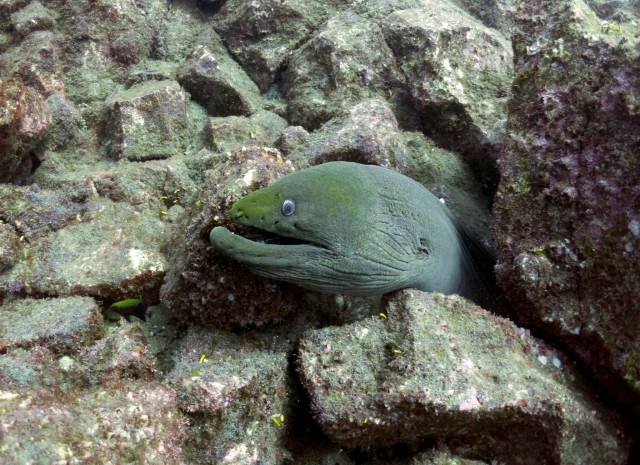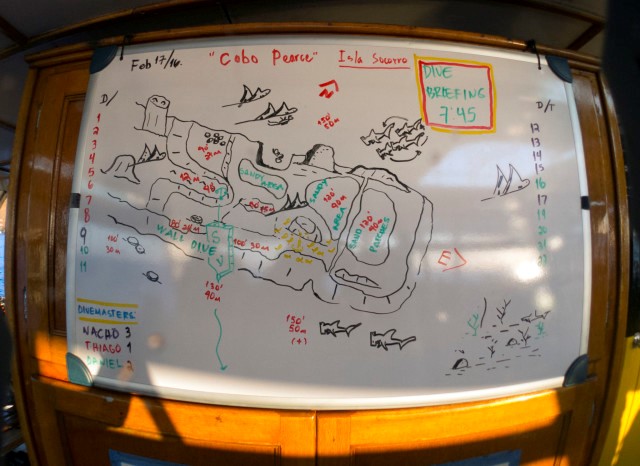News
Diving the Revillagigedo Archipelago: Part 2

Read Part 1 here.
 The island of Socorro is a part of the volcanic Revillagigedo Archipelago, and is inhabited by a small Mexican Navy presence (staff and families) 800 meters from one of the very few fresh water sources on the island. They protect the area from illegal fishing activities and perform rescue operations when needed. Our boat checked in there to register the dive boat’s presence in the area. These islands are located 600km offshore of Mexico, and it takes the Solmar V 24 hours to get to the first island.
The island of Socorro is a part of the volcanic Revillagigedo Archipelago, and is inhabited by a small Mexican Navy presence (staff and families) 800 meters from one of the very few fresh water sources on the island. They protect the area from illegal fishing activities and perform rescue operations when needed. Our boat checked in there to register the dive boat’s presence in the area. These islands are located 600km offshore of Mexico, and it takes the Solmar V 24 hours to get to the first island.
Socorro is a shield volcano (not that I completely understand what that means). Divers love these volcanic islands because of the rich underwater life that inhabits them. There is no fishing allowed, and it is always lovely to dive with animals that haven’t been injured by hooks and lines and nets. As far as I know, there is no other place in the world where you can actually interact with dolphins and mantas in the wild. They are the ones who begin the interactions.
Cabo Pearce, a dive site off of Socorro, was the first place we decided to dive. Our daily schedule went like this:
06.15: Manolo, one of the staff, wakes us up by calling out “breakfast time!”
06.30: Breakfast…whatever you desire! Pancakes, French toast, eggs, bacon, yogurt…. well, you get the idea!
07.20: Get suited up and gear ready.
07.45: Dive briefing. The dive master goes over the dive site, tells you where the formations are, what the currents are like, and where, on the site, you are likely to find certain animals. These dive masters are out here for most of the year, and they know these islands and dive sites.
08.00: in the water! There were 3 groups, and the groups rotate as in who goes in first, second, third. After the first dive, hot chocolate was served and it is delicious. I looked forward to it every day.
10.20: Dive!
12.00/13.00: Lunch…always a soup first. Divers are always hungry.
13.30/14.00: Dive! Then a snack. A different snack daily, from sushi to salami!
15.30/16.00: Dive!
19.00: Dinner. I barely made it until 8.30pm and my eyes were drooping. Four dives a day in strong current is tiring, I can tell you. As the trip goes on you handle it better, but the first few days for me are always exhausting. I was Diver 9.
Taking photos in this location is a completely different experience from taking photos in the Caribbean, where the backgrounds are very colorful with coral. There is not much coral here, it is mostly rock, but there are advantages to that. Coral Reefs can seem like deserts when compared to the number of fish in the Revillagigedoes. I started out not using a strobe, and took photos by adjusting my White Balance underwater. The photos have a sort of “soft” or “cloudy” look, I think.
My next blog will be on San Benedicto Island… and Manta Rays!
For more from Tam, visit www.travelswithtam.com.
Gear News
Introducing the TR-80, IR-50 and CS-30 Regulators from DYNAMICNORD

Whether you are a beginner or a professional diver – with the three new main regulators from DYNAMICNORD, everyone will find their favourite regulator. They all look super stylish.
Excellent performance with the TR-80
Quality and performance are the be-all and end-all for regulators. It is not for nothing that the TR stands for Tec Reg. The innovative design of the TR-80 guarantees absolute reliability – even in ice-cold waters.

Perfect breathing effort at 0.8 J/l / certified for diving in waters below 10 degrees / structural design made of solid brass for best cold protection / membrane-compensated design with dry seal of the first stage / reduced exhalation effort thanks to optimized exhalation membrane and bubble deflector / adjustable Venturi (dive/predive) and adjustment knob for individual inhalation comfort / innovative design of the front cover prevents free-flow in strong currents or when diving with scooters / design made of sandblasted brass, matt chrome finish / 2 HP and 4 LP outlets / mouthpiece made of high-quality, anti-allergic silicone for maximum comfort.


Amazing underwater adventures with the IR-50
The IR-50 is the top regulator for advanced and experienced divers. Natural breathing is the essence of this regulator.

Ideal breathing effort at 0.8 J/l /certified for diving in waters below 10 degrees / compensated membrane / adjustable venturi (dive/predive) and adjustment knob for individual inhalation comfort/ outlet valve and deflector for minimum exhalation effort and reduction of bubbles on the face / design made of sandblasted brass, matt chrome finish / 2 HP and 4 NP outlets / mouthpiece made of high-quality, anti-allergic silicone for maximum comfort.


The Workhorse – our CS-30
For diving centres and diving beginners – the workhorse stands for strong construction, reliability and robustness. Perfect for your training.

Optimal breathing effort at 0.8 J/l /recommended for diving in waters above 10 degrees / non-compensated piston / adjustable venturi (dive/predive) / outlet valve and deflector for minimum exhalation effort and reduction of bubbles on the face / design made of sandblasted brass, matt chrome finish / 1 HP and 3 NP outlets / mouthpiece made of high-quality, anti-allergic silicone for maximum comfort.


Octopus OP-30
The OP-30 is the ideal addition to all DYNAMICNORD regulators. It is identical in construction to the CS-30.

The TR-80, IR-50, CS-30 (DIN & INT) regulators and the Octopus OP-30 are available from DYNAMICNORD dealers and in the online store.
DYNAMICNORD – Your Outdoor Companion.
Marine Life & Conservation
Paul Watson Released as Denmark Blocks Japan’s Extradition Bid

Renowned anti-whaling activist Paul Watson has been released from custody in Greenland after spending five months in detention. Denmark’s Justice Ministry rejected Japan’s request for his extradition, citing insufficient guarantees that his time already served in custody would be credited against any potential sentence.
The 74-year-old Canadian-American was arrested on July 21 in Nuuk, Greenland’s capital, when his ship docked to refuel. His arrest was based on a 2012 Japanese warrant related to a 2010 encounter in Antarctic waters. Japan alleged Watson obstructed operations and caused damage to a whaling research ship during efforts to disrupt illegal whaling. Watson has consistently denied these claims, maintaining his commitment to marine conservation.
Denmark, which oversees extradition matters for Greenland, concluded that while the legal conditions for extradition were met, the lack of assurances from Japan regarding time-served credit made extradition untenable.
In a video shared by his foundation, Watson expressed gratitude and relief, saying, “After five months, it’s good to be out… and good to know they’re not sending me to Japan.” He added that the most difficult part of his time in custody was being separated from his two young sons.
Watson is a pioneering figure in marine conservation, known for founding the Captain Paul Watson Foundation in 2022 after decades of activism with the Sea Shepherd Conservation Society. His bold efforts to defend marine life have earned him widespread support, including from celebrities and conservationists. His work has also been featured in the acclaimed reality TV series Whale Wars.
Watson’s lawyer, Jonas Christoffersen, praised the decision, stating, “We are happy and relieved that Paul Watson is now free.” He added that Watson is eager to reunite with his family and continue his vital work.
The arrest occurred while Watson’s vessel, the M/Y John Paul DeJoria, was en route to the North Pacific with a team of 26 volunteers to intercept a Japanese whaling ship. His foundation described the arrest as politically motivated and emphasized that Watson’s actions were focused on ending illegal whaling practices.
Japan resumed commercial whaling in 2019 after leaving the International Whaling Commission, asserting that whale meat is a cultural tradition. Conservationists, however, continue to challenge these practices, highlighting their impact on marine ecosystems.
Despite the challenges, Watson remains steadfast in his mission to protect marine life and bring attention to whaling practices. His dedication to ocean conservation has made him a globally respected advocate for the environment.
-

 News2 months ago
News2 months agoIconic SS United States to become the World’s Largest Artificial Reef
-

 News3 months ago
News3 months agoBook Review – 52 Assignments: Underwater Photography
-

 Gear News3 months ago
Gear News3 months agoDYNAMICNORD – New German diving brand enters the British market
-

 News3 months ago
News3 months agoExploring Cenote El Pit: A Diver’s Dream
-

 Gear News3 months ago
Gear News3 months agoTry BARE drysuits (and maybe even win one!) this Friday with Sea & Sea at North West Dive Fest
-

 Marine Life & Conservation3 months ago
Marine Life & Conservation3 months agoBook Review: Coral Triangle Cameos
-

 Blogs2 months ago
Blogs2 months agoDive the Egyptian Red Sea this Autumn with Regaldive
-

 News3 months ago
News3 months ago2024 Ocean Art Underwater Photo Competition Announced





















